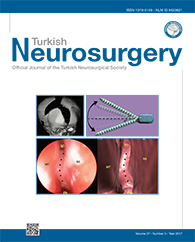2Gazi University, School of Medicine, Department of Neurosurgery, Ankara, Turkey
3Gazi University, School of Medicine, Department of Pathology, Ankara, Turkey
4Gazi University, School of Medicine, Department of Neurology, Ankara, Turkey
5Koc University, School of Medicine, Department of Neurosurgery, Istanbul, Turkey DOI : 10.5137/1019-5149.JTN.16101-15.1 AIM: Cerebral vasospasm is the primary cause of morbidity and mortality after subarachnoid hemorrhage (SAH). Hydrogen Sulfide (H2S), a gaseous neurotransmitter, is produced in many tissues including the central nervous system (CNS). The vasodilatatory effect of H2S has been shown in the CNS; however, its role in cerebral vasospasm has not been investigated before.
MATERIAL and METHODS: The rats were divided into 8 groups: control, SAH, sodium hydrosulphide (NaHS), propargylglycine (PPG), aminooxy acetic acid (AOAA), SAH+NaHS, SAH+PPG, and SAH+AOAA. After establishing experimental SAH, the basilar artery and brain stem were harvested at 24th hours. The diameter and wall thickness of basilar artery were measured. Production of H2S was assessed by showing the activity of cystathionine ?-synthase (CBS) and cystathionine ?-lyase enzymes (CSE).
RESULTS: NaHS treatment significantly reduced vasospasm at 24 hours following SAH. This vasodilatatory effect was correlated with the CSE expression in basilar artery. CSE and CBS enzyme expressions were significantly lower in brain stem and basilar artery in PPG and AOAA-treated groups. PPG and AOAA treatments exerted a vasoconstrictive effect in the basilar artery. There were statistically significant differences between NaHS, PPG and AOAA groups, in terms of basilar artery luminal diameter.
CONCLUSION: H2S may have a therapeutic potential in the treatment of vasospasm with its vasodilatator activity.
Keywords : Cerebral vasospasm, Hydrogen sulfide, Subarachnoid hemorrhage




